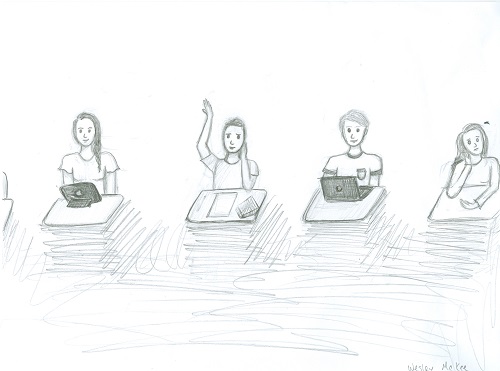
Technological twists and turns
June 13, 2016
“We need technology in every classroom and in every student and teacher’s hand, because it is the pen and paper of our time, and it is the lens through which we experience much of our world.” – David Warlick
In recent years technology has changed the way we think and live, increasing communication worldwide and providing people access to all kinds of information.
Furthermore, incorporating technology into schools is a natural progression as it is becoming so innate in society. However, successful implementation of technology into schools’ curriculum has been scattered and haphazard at best and the United States as a whole has failed to enact a plan that evenly and fairly assimilates technology into the classroom.
One of the primary issues that states encounter when attempting to bring technology into schools is money. It is extremely expensive to fulfill initiatives like “1-to-1 Computing,” where each student is provided a laptop or computer. Oftentimes, technology is incorporated unevenly across class, putting lower-income students at an unfair disadvantage.
According to edweek.com, blended learning is a technology integration approach that combines traditional, teacher-to-student lessons with technology-based instruction. This approach can attempt to combat financial issues by rotating students between online and in-person stations for different parts of the day.
This approach does more than simply replace the traditional whiteboard with a SMART or Promethean board and calling it good. Instead, the educational experience revolves around technology, and the structure is extremely flexible, which would allow schools all across the nation plenty of discretion.
According to Heather Staker’s The Rise of K-12 Blended Learning, there are six different models for the blended learning approach; Ranging from a Face-to-Face Driver style, where the teacher is the main source of information, with some technological additions, to an Online Driver style, where all of the information is delivered via an online course and teacher.
However, 1-to-1 Computing and blended learning are just two of many visions for how to bring technology into the classroom.
Despite deficiencies, the Office of Educational Technology has developed a plan for integrating technology into schools, providing recommendations to shifts in both learning and teaching.
All of these changes call for massive upheaval of the education system, but these changes are necessary in order for students to adapt to the quickly changing world. Instead of merely peppering big budget schools with costly technology, school systems must take a major leap to fully incorporate technology into the classroom.
Without drastic change, today’s students are left unprepared for not only higher education and the working field, but they are also left behind when it comes to society and the future as a whole.
According to Noel and Joe Bitner’s, Integrating Technology into the Classroom: Eight Keys to Success, the knowledge needed to successfully enter the job market is constantly changing. So before they are left behind, students must learn how to utilize technology in order to become productive members of society.
Technology is going to keep improving and thriving the sooner its full potential is realized and welcomed into the education system, the sooner society can grow and thrive as fast as technology does.